You need to have a reliable pair of freediving fins in order to travel farther and faster underwater. There is a big difference between the freediving fins that pros use and what beginners use. The best freediving fins for beginners should be affordable with soft fin blades so that it is easier to ease into.
Even with an entry level freediving fin, you will be shocked at how easy it is to surpass your previous depth records. It will almost feel like you’re cheating compared to diving without fins or with the wrong type of fins
However, in order to achieve results like this, there are a few factors to consider when shopping for beginner freediving fins. In this article, we will go over everything you need to know about the best freediving fins. You will learn about the top brands, materials, design style, how to take care of them and safely bring them when traveling.
Our Top Picks:
What to Look for In the Best Freediving Fins
What features should you look out for in a pair of freediving fins? To start, there are two features that are absolutely essential, and they are 1) closed heel foot pockets and 2) long and soft blades. Of course, these aren’t the only factors you should consider, but they are the most important. Let’s go over why.
Closed Heel Foot Pocket
If you are serious about freediving, you shouldn’t even consider using open heel fins; your only option is closed heel (full-foot) fins. For those unaware, the closed heel foot pocket design on a fin means that the foot pocket completely wraps around your feet, similar to wearing a shoe. This design allows for superior power transfer resulting in greater finning speeds.
On the other hand, the open heel foot pocket design leaves a space by your heel. Much of your foot is left uncovered by material, and the fin is held in place by a small adjustable strap that wraps around your ankle.
Wearing fins with open heel foot pockets feels similar to wearing sandals. You even need to wear water socks or dive booties to keep the strap from digging into your leg. This style tends to result in inefficient power transfer resulting in lower finning speeds.
Alright, now you know a bit about these two fin styles, so what makes closed heel fins better for freediving? Once again, when the rubber material completely wraps around your feet, you get a secure, tight fit. This stable fit gives you greater power transfer per kick, which is important when freediving because you can fin faster with less effort, thus saving you precious oxygen.
In a sport like freediving where each second counts, you need to make every single optimization you can and closed heels are strongly recommended. Going forward, assume each fin we will be discussing is a closed heel fin.
If you just prefer open-heel fins, then we recommend you pair them up with a pair of dive booties. Without dive booties, your feet will be left exposed to the cold water and unprotected from the strap which can dig into you and cause discomfort.
Similarly, closed heel fins can also chafe your skin, so we recommend you wear them with a pair of neoprene water socks for added protection.
Long Blades
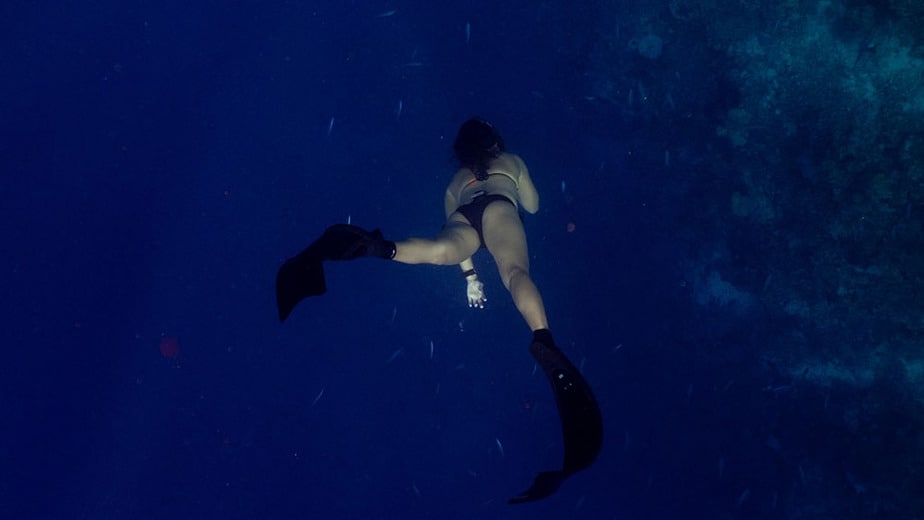
The second important factor to look for when shopping for freediving fins for beginners are long fin blades. Do NOT get short fin blades.
Freediving fins with long blades displace more watch with each kick, resulting in greater kicking efficiency. In other words, when you kick with long-bladed fins, you will travel longer distances at faster speeds all while exerting less effort and conserving precious oxygen.
With short fins, you will be rapidly kicking and feel like you’re barely moving. It’s like trying to pedal a bike on first gear; you’re spinning your wheels and burning through your energy and oxygen reserves and not getting anywhere. Meanwhile your competitors zoom past you in fifth gear and can stay underwater for longer.
Again, if you are serious about being a competitive freediver and realizing your full potential, you should get freediving fins with long blades.
Now that we’ve covered the two most important factors when selecting beginner’s freediving fins, next we’ll cover some additional considerations that you can keep in mind as well.
Soft Blades
If you’re a freediving novice, you’ll want to keep an eye out for fins with soft blades. These will let you get used to them and develop your leg muscles as well as finning technique during shallow dives.
More often than not, beginners will purchase a super expensive, ridiculously long and durable carbon fiber fin – because that’s what the pros wear – only to find that they can’t handle the physical strain that it puts on their body. They end up disappointed that their legs get cramping up, they were out of breath the whole time, and they couldn’t get the performance they expected.
Learn the proper technique and build up your fitness level with soft blades
Even if you are very physically active, you should probably still practice with soft blade fins. Why? You want to learn the perfect technique as a beginner, because it’s hard to break out of a bad habit later on. It’s very easy to develop poor finning habits if you start out with stiff blades.
In a sport, athletic ability is certainly important, but technique is just as important. A good athlete will excel not only in terms of raw power but also due to skillful movement. Learning any new activity requires repetitive and diligent training so that you can perfect the motions needed to perform the task.
The reason that stiff fins are not recommended is that due to their inflexibility, an inexperienced diver will bend their legs by the knee to instinctively compensate for the strong resistance. This is a mistake. Your legs should remain relatively straight, which can feel awkward if you’re not used to finning.
Furthermore, regardless of one’s fitness level, there is a tendency for beginners to develop an imbalanced stroke where they kick back harder since moving the fins is easier in that direction. Having to undo these bad habits later on can be a nightmare, but starting out with soft blades will keep you from developing most of them.
Conserve Energy Along the Surface
As a novice, much of your freediving activity will take place near the surface of the water, where you can easily tire yourself out from the difficulty. You don’t want to exhaust yourself before you’ve even had a chance to practice deeper dives. Only when you have become proficient at finning and have improved your overall fitness level should you consider upgrading to a stiffer fin.
Best Freediving Fins for Beginners Review
Cressi Gara Professional LD
- Sport Type: Outdoor Lifestyle
Without a doubt, the best freediving fins for beginners is the Gara Professional LD by Cressi.
Affordable: To start, they are high-quality and affordable, making them the ideal candidate for a low-risk, entry-level investment for beginners looking to get into the sport. You can expect the average high-end freediving fin to be at around $300. As an advanced freediver, this is a fair price to pay.
However, as a beginner that is a huge sum of money to spend on something that you aren’t even sure about. Your goal should be to find a solid pair of long freediving fins that are good enough to get you started with technique training and building your endurance. Once you’ve perfected that, then you can consider investing in high-end equipment (more on “high-end” equipment later).
Blade Material: The Gara Professional LD comes with elastomer polypropylene blades which are durable and economical. However, these blades have a downside which is that they can feel uncomfortably stiff starting out. It may take a few training sessions for you to get comfortable with its stiffness and the effort needed to kick with them.
You won’t be used to finning with long blades starting out. There’s no way to get around it other than to train until you develop strong, powerful legs through diligent training with long fins. Thankfully, the Gara Professional LD fin blades are made from an elastomer-polypropylene blend which makes the blades softer and more pliable.
What this means is that you can get the same power of stiffer fins with less effort. Once you put these fins on, you will soon be slicing through the water at incredible speeds while spending less energy and conserving oxygen levels. It’s not cheating, it’s being smart.
Full-Foot Fin Pockets: We said it before, but closed-heel fins are the ideal design for a freediving fin. The Gara Professional LD will wrap around your feet in such a way that the blade will be angled at a higher insertion point above your feet.
This will help you perform highly efficient kicks with great thrust that propels you through the water until you reach your desired depth.
With the Gara Professional LD, you get performance that almost rivals high-end freediving fins from a trusted, reputable brand in the water sports market. You should also pick up a pair of 2-3mm neoprene socks to prevent chafing, provide insulation, and achieve a snug fit.
Best Bi-Fins for Advanced Freedivers
Once you’ve got some freediving experience under your belt, you might start to feel like you’ve “outgrown” your plastic/elastomer fins. It is common to experience this feeling after one to two years and that means it is time to upgrade your fins to something more sophisticated.
Generally, the average freediver will follow this upgrade path:
- Start with Plastic Elastomer Fins and use for one to two years.
- Upgrade to Fiberglass fins and use for one year.
- Upgrade to Carbon Fiber and use it for 5+ years.
You can even skip step 2 and just go from plastic freediving fins to carbon fiber for both practical reasons and economical ones.
The upfront cost is more because carbon fiber is $100 more expensive than fiberglass, however you are paying for the best. However, in the long run it is cheaper if you invest upfront since you don’t have to buy an extra pair of fins only to upgrade it a year later.
Additionally, with carbon fiber fins you can get instant gratification once you experience the speed boost that only the freediving fin made with the best materials on the market can provide.
Leaderfins Pure Carbon Fiber
- The blade is made from a high quality mixture of epoxy resin and carbon fibre.
- Angle 20 degrees
- Foot pockets are very different from regular shoes and hence we strongly recommend you to follow the guide in the last picture of the listing in order...
A good starter carbon fiber fin is the Leaderfins Pure Carbon Fiber. This fin features stiff foot pockets for additional thrust, with a soft fin blade that is simultaneously easy on your legs while packing a powerful kick. Seriously, this fin is unbelievably easy to fin with (you don’t need legs the size of tree trunks to use it).
For its price, you are getting an incredible deal when compared to the cost of other carbon fiber fins. Once you’ve had a chance to try out the Leaderfins Pure Carbon Fiber fins, you will be blown away by how far one kick will propel you; it almost feels like you’ve got boat propellers instead of fins.
C4 Martin Stepanek
- NEW Industry unique TR50 Carbon fiber construction
- 22 Degree Angle
- Comes with OMER foot pocket
Since you’re already spending a pretty penny, you might want to consider investing in the best overall carbon fiber freediving bi-fins, and that is the C4 Martin Stepanek freediving fins. You can select from three fin stiffnesses so that you can choose the optimal fin that is both comfortable and offers great performance in the water.
What makes the Martins stand out is how light they are. Swimmers and freedivers need swimsuits that are form-fitting to reduce drag. The next optimization to make is to wear incredibly light fins so that freedivers can slice through the water to outperform the competition. Your gear should help you perform better, not hinder you!
Since the C4 Martin Stepanek is light as a feather, you can be fast and agile in the water, allowing you to swim like you’re part fish.
Traveling with Long Freediving Fins
No matter how you plan on traveling – by plane, boat, or car, you need a durable and robust bag that is large enough to carry all of your freediving gear. Unfortunately, due to the length of freediving fins, they won’t fit in any diving bags.
Most diving bags measure in at 35 inches in length. Most freediving fins are longer than that by about 3-4 inches. In other words, good luck trying to pack your fins in that. And no, bending the fin blades is not an option!
It’s not a bad idea to invest in a dedicated bag for your freediving fins. However, you could also invest in the Palantic Fins bag (B00BQ1DUE0), currently one of the top fin bags on the market. At 40 inches long, this bag can just barely hold most long freediving fins.
We strongly believe that you should invest in a dedicated freediving fins bag. Particularly if you have invested in a pair of carbon fiber fins, you should not be exposing your expensive fins to scratches and dents. They must be kept in a bag, otherwise your fins will suffer wear and tear at an extremely fast rate.
Particularly if you are traveling by plane, your fins must be kept in a bag. We even recommend you bring it with you as carry-on. Relatively speaking, the cost of a fin bag is very low compared to what you’d have to pay to replace your trusty pair of fins.
If possible, try to bring your fins with you as carry-on. In my experience, airline staff don’t mind but they may be curious about your fins. In any event, whether you check your luggage in or bring it with you, your fins ought to be kept in a bag.
Freediving with a Monofin
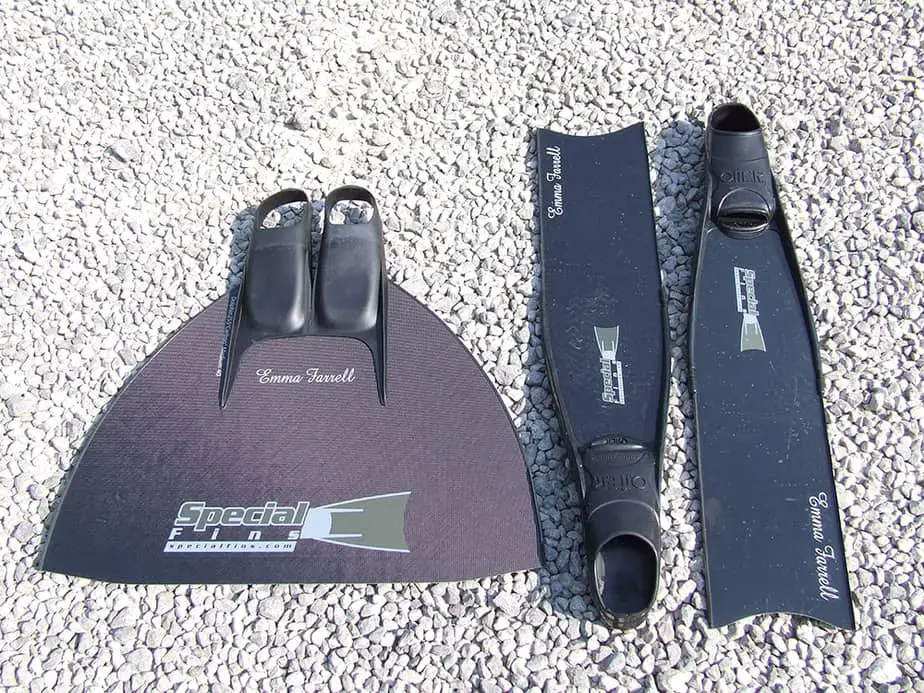
As a beginner, you don’t need to concern yourself with this. However, if performance is what you’re looking for, then one day you may end up using a monofin. They are the most efficient and effective type of freediving fin you can get.
When you use a monofin with good dolphin kicking technique, you will achieve speeds that surpass bi-fins. Monofins are different from bi-fins in that there is only one fin blade instead of two. That singular large blade is similar to the flipper found on dolphins. Both foot pockets are located next to each other and connected to the same fin.
Since you cannot separate your feet, turning in the water becomes a nightmare, and both feet must move at the same time in order to kick. Despite this, monofins provide the best performance, allowing freedivers to achieve speeds 10% to 40% faster than bi-fins.
When it comes to efficiency, speed, and depth moving in straight lines then the monofin is the best option for you. Since monofins are so different from other fins, it will feel very awkward using them in the beginning.
With that said, we do not recommend investing in a monofin if you plan on doing any water activities other than competitive freediving. They are not ideal for cave diving, underwater photography, spearfishing, or casual diving.
Monofins are designed and intended for competitive freedivers that are trying to set new world records and surpass other freedivers. They are not made for the casual freediver; they are built for unmatched speed. For the vast majority of freedivers, the bi-fins mentioned above will be sufficient for almost all cases.
If you are still interested in getting a monofin, then check out the Leaderfin Monofin. Measuring in at a whopping 28” x 28”, the large blades will displace large amounts of water with each kick. The blade is flexible and will snap back to their original position after each kick (this is the secret behind the monofin’s exceptional performance).
- The blade is made from a high quality multilayered fiberglass
- Supplied with free neoprene socks
- Foot pockets are very different from regular shoes and hence we strongly recommend you to follow the guide in the last picture of the listing in order...
Freediving Fin Buying Guide for Beginners
Design
If you’re just starting out, then the best freediving fins for beginners are ones with fixed blades. They are cheap, easy-to-use, and very durable. There’s no need for any complicated assembly or maintenance, just slip them on and dive in. The downside of fixed blades is that as you improve as a freediver, if you want to make an upgrade then you have to purchase a new pair of fins.
On the other hand, there are modular freediving fins which give you the option to upgrade the blades as you see fit. Beginner modular fins come with plastic blades, and you can upgrade to carbon fiber of fiberglass blades in the future for better performance. The downside of modular fins are their high price compared to fixed blade fins. Also, they are not as durable so you will have to take extra care to keep them safe.
Durability
As mentioned above, entry-level freediving fins with fixed plastic blades are more durable than carbon fiber or fiberglass blades. Sometimes the stiffness and durability of fixed blades is taken advantage of by spear fishermen and advanced freedivers who prefer the lower sensitivity.
Some divers also prefer to use their inexpensive, basic plastic blade fins for diving in rocky or rough areas where the risk of damaging their high-end blades is higher. If you have a spare pair of fins, then use them whenever you aren’t boat diving or training to keep the risk of damage lower.
You must be careful to avoid damage even when traveling. That is why you should buy a dedicated fin bag to store your fragile modular fins when not in use.
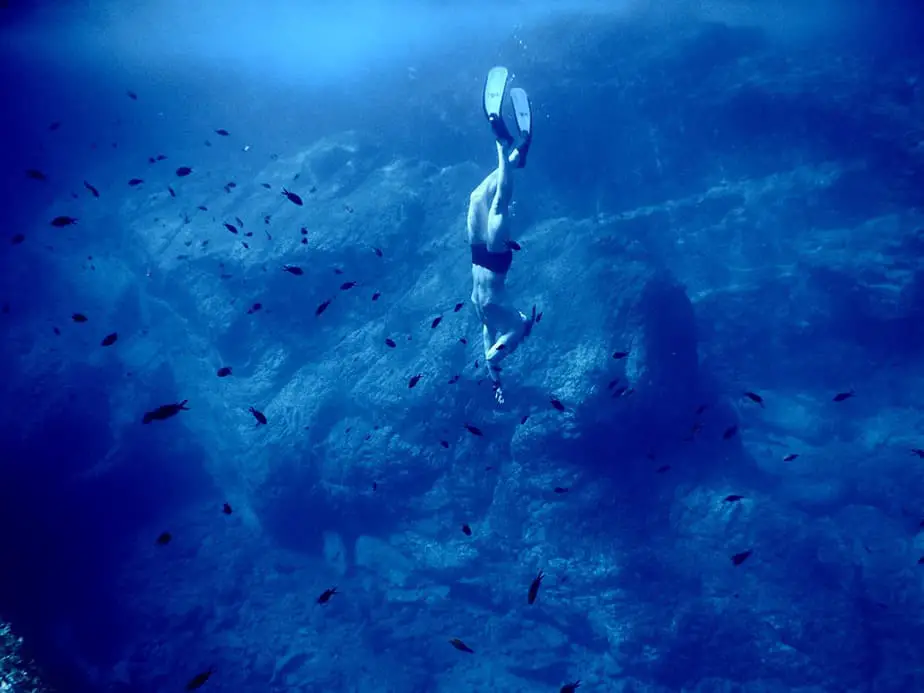
Stiffness
If you opt for fixed plastic blades on your beginner freediving fins, check that the stiffness is something that your body can handle. You can do this by searching the fin manufacturer’s website or product description about its hardness.
For the most part, as a beginner or someone who simply wants to do long distance swimming by the surface, it is recommended to choose blades that are soft or have a medium stiffness rating at the most. Stiff, rigid blades are difficult to swim with.
To properly use stiff blades, one needs to have powerful leg muscles and a large body type to have the power to continuously propel their body through the water using stiffer blades.
Price
When starting out, you should look for affordable freediving fins. While learning the ropes on how to properly freedive, it is really common to damage the blades due to rocks or improperly storing them when traveling. There’s no need to get the best of the best for your first pair of fins.
Even after you’ve got some experience with freediving and are looking to upgrade to the next pair of fins, don’t just look at the price. We’ve listed many other considerations in this guide, and if a pair of fins fulfills your needs and can help you reach your freediving goals, then get that pair.
Sizing
Sizing is always an issue when you shop online and can’t try it on in-person. For something as important as freediving fins where a snug fit is necessary, correct sizing is crucial. Here is where most people go wrong.
The majority of freediving fins are made by European manufacturers, so the best point of comparison is to take European size convention into account when buying a pair. Unfortunately, this is not foolproof because the conversion from US to European sizing can vary across retailers.
The best way to solve this issue is to manually measure your foot yourself, instead of relying on your regular size and converting it to European standards. Also read the customer reviews to see what other people have found out regarding sizing for a particular fin.
Barefoot or with Water Socks?
When you are shopping for a freediving fin, you have to consider if you will be wearing neoprene water socks or wearing the fins barefoot. Most fins are sized such that a correctly sized pair fits a little loose barefoot. The expectation is that you will be wearing a 2-3mm water sock in order to achieve a snug fit.
Even if you only plan on swimming in tropical waters, you should probably still wear neoprene socks for the extra insulation. The deeper you dive, the colder the water gets even in a warm climate, so extra insulation to keep your feet comfortable and warm is nice. It can also help you conserve energy, since cold feet don’t work as well.
Length
Travelling with a full-length pair of freediving fins can be a hassle, and we recommend you purchase a dedicated bag for them. The bag should also have extra space to accommodate your snorkel and mask, and perhaps a wetsuit as well.
Since these bags are long, you might be tempted to check it in. However, we feel it is safer to bring with you as a carry-on luggage when flying. These items are fragile, and you don’t want inconsiderate airline staff to pile a bunch of heavy baggage on top of it and damage it.
Freediving Fin Care
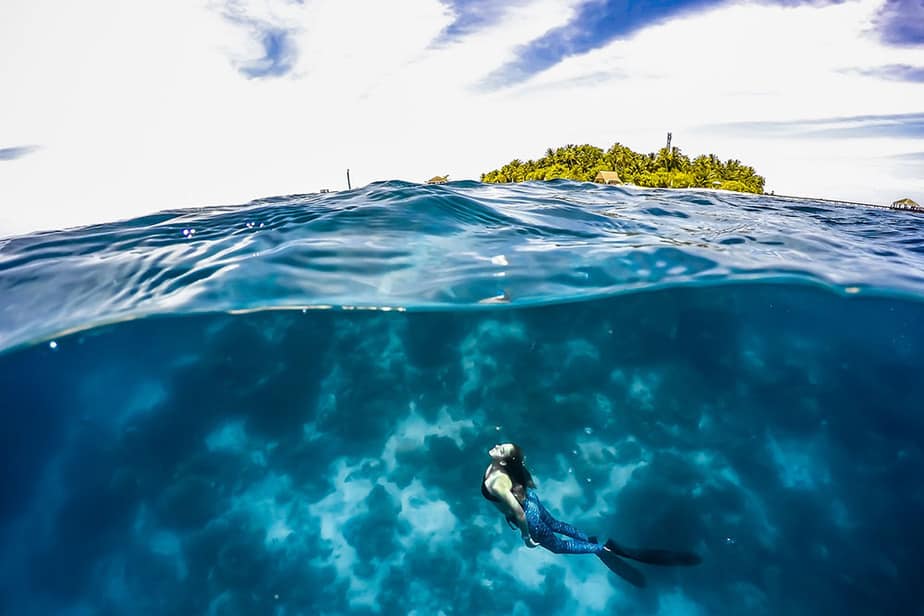
The materials that freediving fins for beginners are made from are durable when used in the proper context. They should be able to withstand wear and tear, however their long length does make them more fragile than standard snorkeling or SCUBA fins. This is especially true if you bought yourself a pair of modular fins.
It is better to err on the side of caution and treat them like they are fragile. This will put you into the right state of mind for when you decide to upgrade to the more expensive and delicate carbon fiber or fiberglass fins.
When you’re not wearing them, always store your fins in the dedicated bag. After each freediving session, thoroughly rinse them and dry them in a well-ventilated place away from direct sunlight.
When putting them on and taking them off, try to do so exclusively in the water so that you don’t have to walk very much in them. Not only is it very easy to trip over the fin blades, but you can easily damage them. Just treat them like they are special equipment (because, well, they are) and you should be able to keep them safe.
Best Freediving Fins for Beginners Recap
When shopping for a pair of freediving fins for beginners, the two most important factors are a closed heel foot pocket design, and long, soft fin blades. Fins with a full-foot design will wrap tightly around your feet for the most secure fit.
Long blades are important because they will generate more thrust with each kick. The fin blade should also be relatively soft for beginners otherwise they will be too hard to practice with. When starting out with freediving, one must quickly build up their leg muscles to be capable of kicking with long fins.
Furthermore, one must learn the proper finning technique when diving in order to be more efficient underwater. Entry level fins are typically made from plastic, and higher end ones are made with carbon fiber or fiberglass. Beginner freedivers should start with long plastic fins and use those for a year to learn the technique and get used to the fins.
Afterwards, one can decide to upgrade to modular carbon fiber or fiberglass fins. These materials are lightweight and help slice through the water with each kick. Once you have expensive fins like these, you must strive to take good care of them.
You should invest in a dedicated fin bag for your freediving fins. Since most freediving fins are around ~38.5” in length, your bag should be even longer than that. Without a bag to store your fins, they can easily get scratched, especially when traveling. When traveling by plane, try to bring your fin bag as a carry-on if possible.
Try to put on and take off your freediving fins only in the water. This will limit how much you need to walk with them. Since freediving fins are so long, it is easy to trip over them or damage them when walking.
Once you’ve got yourself a solid pair of freediving fins for beginners, you will be able to jet through the water to depths you’ve never reached before. Furthermore, by taking proper care of them you will be able to use them for years to come.
You may also be interested in our other gear reviews:
- Click here to read our freediving weight belt review.
- Click here to read our freediving watch review.
- Click here to read our dive buoy and line review.
Last update on 2024-04-01 / Affiliate links / Images from Amazon Product Advertising API

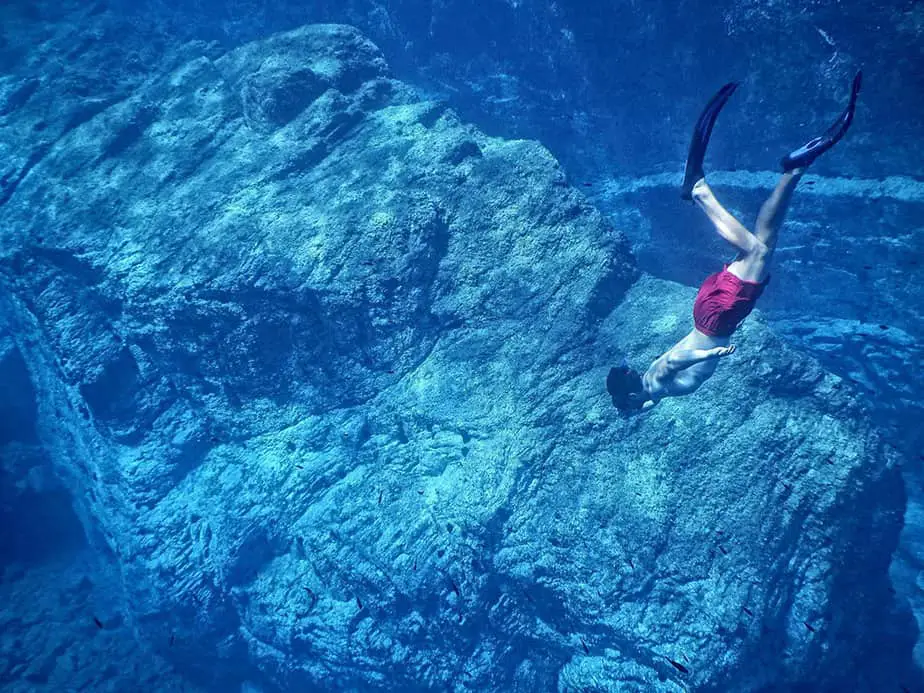
![Cressi Gara Professional LD [44/45]](https://m.media-amazon.com/images/I/41t02hTHvxL.jpg)



